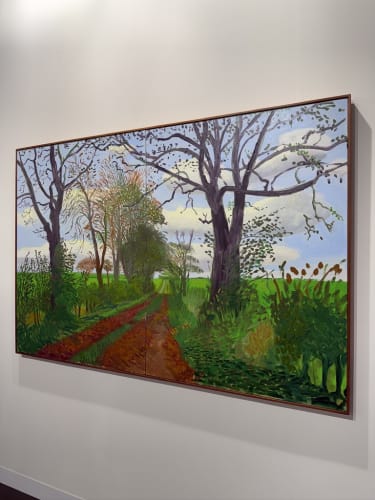Art Basel’s flagship returned to Messe Basel with 289 galleries from 42 countries and roughly 88,000 visitors, a shade down on last year but lively on the aisles. The week even had its own quirky subplot: a limited run of Labubu dolls at the Art Basel Shop vanished in 23 minutes, a reminder that demand comes in many forms.
On the sales front, the preview day set a confident tone. Annely Juda Fine Art fielded the headline result with David Hockney’s Mid November Tunnel (2006) in the $13m–$17m range. David Zwirner followed with a Ruth Asawa hanging sculpture at $9.5m and a Gerhard Richter canvas at $6.8m. At Hauser & Wirth, two Mark Bradford paintings placed at $3.5m each alongside strong outcomes for George Condo ($2.45m), Jack Whitten ($2m) and Frank Bowling ($1.85m). Thaddaeus Ropac reported a Georg Baselitz painting at €3.45m, while Pace placed a late Agnes Martin above $4m. The pattern was clear: top material with strong provenance could still command decisive prices.
As the week settled, buying became more deliberate. Dealers spoke of longer decision cycles, heavier due diligence and a market that felt selective rather than exuberant. The most reliable depth sat between $100,000 and $1m, with fewer fireworks at the very top end and fewer US collectors on the floor than in some recent editions. Institutions were active, and a noticeable amount of business shifted to follow-up and private channels.
Beyond the booths, the city provided memorable moments of its own. Katharina Grosse’s CHOIR flooded the Messeplatz in magenta and white for the week only, a pleasing counterpoint to the commerce inside. In Unlimited, large-scale statements drew steady crowds, with Marinella Senatore’s We Rise by Lifting Others among the most photographed.
At the emerging end, the Statements sector delivered its usual pulse check. The Baloise Art Prize went to Joyce Joumaa and Rhea Dillon, with acquisitions earmarked for MMK Frankfurt and MUDAM Luxembourg—useful institutional endorsements in a year where credibility mattered as much as momentum. Prices here mostly sat in the lower five figures and placed into museum and seasoned private collections.
Against the wider backdrop, the mood made sense. The Art Basel & UBS Art Market Report pointed to a 12% fall in global sales last year to $57.5bn, with activity migrating toward lower price bands even as volumes held up. Basel reflected that reset: quality still commanded attention, but buyers were patient, and pricing discipline was front and centre.
By week’s end, the consensus was measured but positive. If the fair lacked the froth of a boom year, it offered something arguably more useful: clarity. Exceptional works still found homes at serious levels; mid-market material moved when well pitched; and the best presentations balanced ambition with realism. In a market learning to live with tighter conditions, that felt like a sensible result.
References:
-
Art Basel — “Art Basel’s 2025 edition concludes on a high note”
-
Art Basel — “Art Basel 2025: sales across all sectors signal market resilience”
-
SWI swissinfo.ch — “Art Basel 2025 attracts over 88,000 visitors”
-
Reuters — “Art Basel shows more mid-priced art to a sombre market”
-
Ocula — “Art Basel 2025 Receipts: A Market in Deliberate Transition”
-
Baloise — “26th Baloise Art Prize awarded at Art Basel 2025”
-
The Art Newspaper — “Sculptural works by emerging artists win Baloise Art Prize”
-
Gagosian — “Art Basel Messeplatz Project 2025 | Katharina Grosse”








